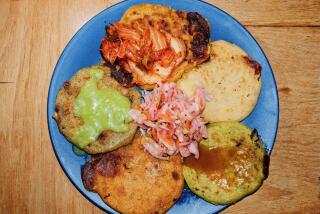Home-Style Peruvian
In Huntington Beach, ethnic dining once meant a fish taco and a Corona with a wedge of lime. How times change. Today, Beach Boulevard is chockablock with exotic restaurants.
The phenomenon has even spread to several residential streets. Case in point: Imperial Inka, which looks like a Marie Callender gone Peruvian.
Owner Enrique Mendez is an affable, articulate gent who greets you like a long-lost friend. His personality alone is enough to make the restaurant upbeat, but his two dining rooms are almost dazzlingly bright and cheerful, with their mirror-decorated walls, brass-framed booths and Peruvian crafts.
Peruvian cuisine is a distinctive amalgam of Spanish and Inca traditions, with an unexpected dash of Chinese. Peru gave the world the potato, and to this day the country has thousands of potato varieties not grown elsewhere. Ceviche, raw fish marinated in lime juice, is another dish native to Peru. It is also one of the best things on Imperial Inka’s menu.
There is no beer or wine here, but the drinks are interesting. If you have a bit of the anthropologist in you, begin with a glass of chicha morada, a purple drink made from fermented purple corn. It has an assertively medicinal finish, but it sort of grows on you. Mendez will probably suggest an Inca Kola, which I’d definitely call an acquired taste. It’s a pale yellow Peruvian soft drink that tastes to me like bubble gum.
I begin every meal here with one of the ceviches, both of which taste wondrously fresh. Ceviche de pescado is made with halibut, a more delicate choice than the snapper most of our Peruvian restaurants use for this dish. Ceviche mixto combines the halibut with squid and baby shrimp. Both ceviches come with pungent salsa criolla, which in Peru means thinly sliced onions and parsley soaked in vinegar.
One off-menu appetizer to ask about is papa rellena, a homey, inviting dish that looks like a giant mashed potato patty. It’s stuffed with ground meat, olives and raisins and fried in butter. I like it best with a little dollop of aji, a condiment made from yellow Peruvian chiles, milk and cheese.
The most Peruvian potato dish on the menu is papas a la Huancaina, or potatoes cooked in the style of the city of Huancayo in northern Peru. For this dish, whole boiled potatoes are blanketed in a rich, yellow sauce of cheese, cream, chiles and olive oil. This is a stick-to-the-ribs dish and not to every taste, since it’s typically eaten cold.
If this is all too potato-oriented for you, consider starting the meal with a Salvadoran-style corn tamale, a cylinder of soft masa filled with chicken and vegetables. How did it get on the menu? It’s made by the owner’s wife, who’s from El Salvador.
Hearty, warming soups are popular in mountainous Peru. Parihuela is a deliciously spicy seafood soup made with fish, shrimp, mussels, squid and a touch of white wine. Menestron is big chunks of beef with carrots and onions in a basil-flavored broth. It’s more like a beef stew than a soup.
*
On my first visit, Mendez suggested two dishes introduced to Peru by Chinese immigrants, who are prominent in the country’s restaurant trade. Arroz chaufa is fried rice (chaufa is the Cantonese chow fun) with large pieces of boneless chicken, fried eggs and chopped green onions. The other is an oddball dish named kam-lu won ton. It’s meaty fried won tons in a sticky-sweet red tamarind sauce, along with shrimp, breaded pork and grilled beef. It’s a lot better than it sounds.
Chicken is prepared several different ways here. Aji de gallina is shredded chicken in a starchy cheese sauce flavored with yellow chiles; I find it cloying after two or three bites. The more appealing arroz con pollo is pieces of boiled chicken smothered in a fragrant rice pilaf tinged green with cilantro. Roasted chicken, a Peruvian favorite, is disappointingly dry and overcooked here.
There are several beef dishes as well. Lomo saltado is strips of lean top sirloin sauteed with onions, tomatoes and French fried potatoes; call it fajitas, Peruvian style. It’s delicious. Bisteck apanado is like a leathery chicken-fried steak, without country gravy.
And asado is virtually the same as a good Yankee pot roast, from the carrots and onions on top of the meat to the dense mashed potatoes on the side. Those who like to combine beef with garlic should order tacu tacu con bistecko frito, a pounded steak fried and served over stir-fried rice with beans, onions and garlic.
Desserts range from the exotic to the banal. The best is helado de lucuma, an ice cream made with a Peruvian fruit that tastes like a cross between a fig and a raspberry. Arroz con leche is a creamy rice pudding dusted with cinnamon. Crema volteada is a gelatinous and unappealing version of flan with watery caramel sauce.
This isn’t quite an accomplished restaurant yet, but any meal here is a cultural encounter, and certainly a new experience for the area.
And for those truly interested in this cuisine, Mendez has provided an unusual service. On Imperial Inka’s web page (https://i-mis.com/adv/restaurant.htm), Mendez gives hundreds of authentic Peruvian recipes so you can try reproducing this interesting cuisine yourself.
Imperial Inka is moderately priced. Appetizers are $5.90 to $8.95. Soups are $6.90 to $9.90. Entrees are $4.99 to $18.
BE THERE
* Imperial Inka, 15070 Edwards St., Huntington Beach. (714) 899-5541. Open 11 a.m.-10 p.m. daily. MasterCard and Visa accepted.
More to Read
Eat your way across L.A.
Get our weekly Tasting Notes newsletter for reviews, news and more.
You may occasionally receive promotional content from the Los Angeles Times.









